In my last post , I given general description of Khajuraho Groups of Temple, a UNESCO World Haritage Site. In this post I will give the detail description regarding how these amazing structure came up and built by thousands of hands.


Travel Tips: It is recommended to hire a bicycle (30 INR per day) for a comprehensive orientation to Khajuraho and other temples around. Western Group of Monuments fall in the heart of the town, other monuments are a bit away so bicycle would be better company. If up for a long ride then you can travel all the way till Raneh falls (40 km return journey), Pandav falls in one day bicycle trip. Other than traversing through the temples, you can also visit Archeological museum which lies in the heart of the city. Museum timings are 9:00 AM to 5:00 PM (Closed on Friday).
It was known as Vatsa in ancient time Jejakbhukti in medieval times and Bundelkhand from 14th Century. Khajuraho played a significant role in Indian history. The chandelas who rose to power during the early 10 th century A.D made their capital at Khajuraho and decorated the place with tanks and temples. According to local legends there were 85 temples but now around 25 survived in varying stages of preservation. The place lost its importance around 1500 A.D. Most of these temples are built of sand stone, except the chausath yogini brahma and lalgaun Mahadeva which are constructed of Granite. The temples belong to the Shaiva, Vaishnava & Jaina Sects & they mark the culmination of the central Indian temple building style revealing distinctive peculiarities of plan and elevation. These compact temples without any enclosure wall are erected on a high platform. Normally the temple consists of Garbhagriha (Sanctum),Antarala (Vestibule), Mandapa & Ardhamandapa (Entrance Porch).
The Khajuraho temples mark the highest development of Indian architecture design. The sculptures represented at Khajuraho include the cult images, Parivara devatas (Family deities), Apsaras or Sura-Sundaris, secular & animal sculptures can be seen at Kandariya Madadeva Temple which displays tall & slender figures with distinctive physiognomy.

The erotic figures have given us the finest sculptural compositions
which vibrate with the rare sensitiveness & warmth of emotion and
remarkable for their sculptural quality. The most important temples at Khajuraho include Lakshman vishwanatha, Kandariya Mahadeva, Jagadambi, Chitragupta, Dulhadeo, Parshavanatha, Adinatha, Vaman, Javari and Chaturbhuja.
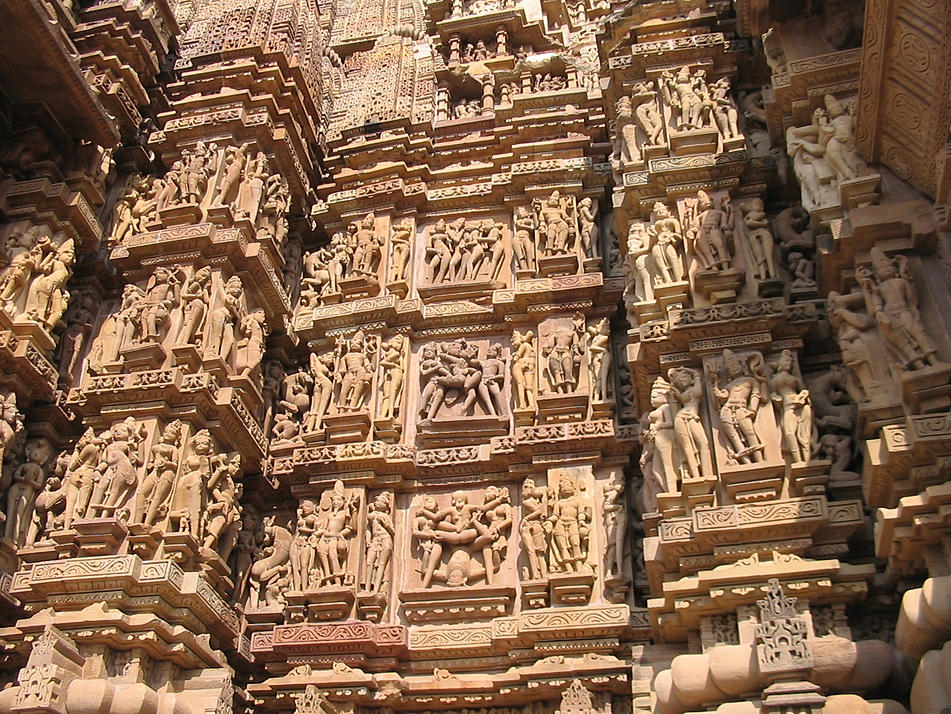
Sculptures on the outer walls of Laxman temple
Western Group of Temples
1.Varaha temple: The varaha shrine, built on a lofty plinth, is simple and modest. It is an oblong pavilion with a pyramidal roof op receding tiers, resting on fourteen plain pillars. The temple enshrines a colossal monolithic image of varaha, the boar incarnation of vishnu. The shrine is built entirely of sand stone. It is dated to circa 900-925 A.D.
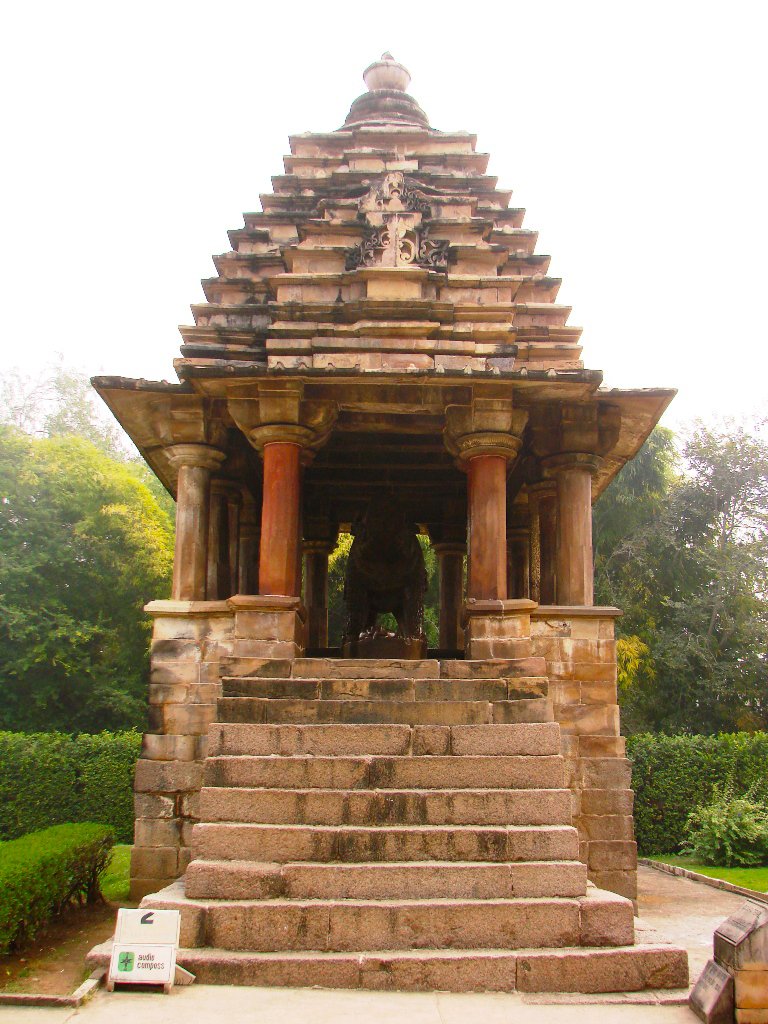
Varah Temple
2.Lakshmana temple: The temple dedicated to vishnu, is built by chandella ruler yashovarman between circa 930-950 AD. It is a sandhara temple of the panchayatan variety.the entire temple complex stands on a high platform. The structure consist all the principal elements of a developed temple the entrance porch (ardha mandapa), mandapa, maha mandapa, antarala and garbhagriha.

Lakshmana temple
Unlike other temples, its sanctum is pancha ratha on plan and its sikhara is clustered with minor sikharas. the wall portion of the temple is studded with balconied windows with ornate balustrades. Two rows of sculptures including divine figures, couples and erotic scenes adorn the wall surfaces.The sanctum doorway is of seven sakhas. The central one being decorated with various incarnation of vishnu. The lintel depicts laxmi in the centre flanked by brahma
and vishnu. The sanctum contains an image of four armed vishnu.

Erotic carving on the wall of Lakhaman Temple
3.Kandariya mahadeva temple: The temple built between circa 1025-1050 ad is the largest and the loftiest monument of khajuraho dedicated to lord shiva. It consists of an entrance rprch(artpha mandapa),mandapa,maha manoapa, antarala(vestsule) and garbhagriha (sanctum).the sanctum is enclosed by a pradakshinapatha (ambulatory passage)
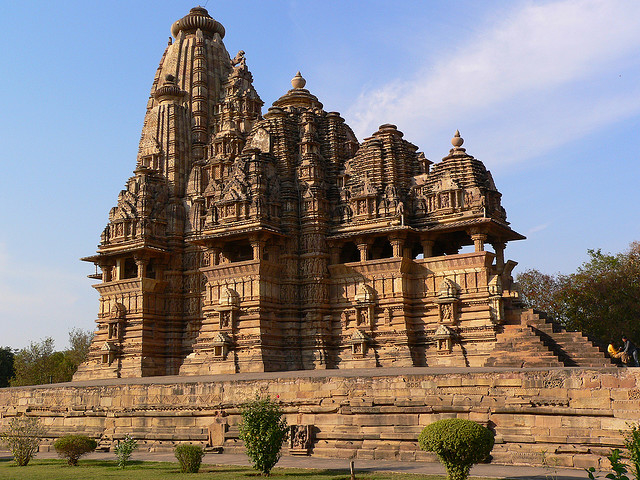


Stone Carving and sculpture on the wall of temple
Khajuraho: Temples, Sculptures, Faith or Erotism
Temples Layout Map

Travel Tips: It is recommended to hire a bicycle (30 INR per day) for a comprehensive orientation to Khajuraho and other temples around. Western Group of Monuments fall in the heart of the town, other monuments are a bit away so bicycle would be better company. If up for a long ride then you can travel all the way till Raneh falls (40 km return journey), Pandav falls in one day bicycle trip. Other than traversing through the temples, you can also visit Archeological museum which lies in the heart of the city. Museum timings are 9:00 AM to 5:00 PM (Closed on Friday).
It was known as Vatsa in ancient time Jejakbhukti in medieval times and Bundelkhand from 14th Century. Khajuraho played a significant role in Indian history. The chandelas who rose to power during the early 10 th century A.D made their capital at Khajuraho and decorated the place with tanks and temples. According to local legends there were 85 temples but now around 25 survived in varying stages of preservation. The place lost its importance around 1500 A.D. Most of these temples are built of sand stone, except the chausath yogini brahma and lalgaun Mahadeva which are constructed of Granite. The temples belong to the Shaiva, Vaishnava & Jaina Sects & they mark the culmination of the central Indian temple building style revealing distinctive peculiarities of plan and elevation. These compact temples without any enclosure wall are erected on a high platform. Normally the temple consists of Garbhagriha (Sanctum),Antarala (Vestibule), Mandapa & Ardhamandapa (Entrance Porch).
The Khajuraho temples mark the highest development of Indian architecture design. The sculptures represented at Khajuraho include the cult images, Parivara devatas (Family deities), Apsaras or Sura-Sundaris, secular & animal sculptures can be seen at Kandariya Madadeva Temple which displays tall & slender figures with distinctive physiognomy.
Erotic Image on temple Wall inspired by Kamsutra

Sculptures on the outer walls of Laxman temple
Western Group of Temples
1.Varaha temple: The varaha shrine, built on a lofty plinth, is simple and modest. It is an oblong pavilion with a pyramidal roof op receding tiers, resting on fourteen plain pillars. The temple enshrines a colossal monolithic image of varaha, the boar incarnation of vishnu. The shrine is built entirely of sand stone. It is dated to circa 900-925 A.D.
Varah Temple
2.Lakshmana temple: The temple dedicated to vishnu, is built by chandella ruler yashovarman between circa 930-950 AD. It is a sandhara temple of the panchayatan variety.the entire temple complex stands on a high platform. The structure consist all the principal elements of a developed temple the entrance porch (ardha mandapa), mandapa, maha mandapa, antarala and garbhagriha.

Lakshmana temple
Unlike other temples, its sanctum is pancha ratha on plan and its sikhara is clustered with minor sikharas. the wall portion of the temple is studded with balconied windows with ornate balustrades. Two rows of sculptures including divine figures, couples and erotic scenes adorn the wall surfaces.The sanctum doorway is of seven sakhas. The central one being decorated with various incarnation of vishnu. The lintel depicts laxmi in the centre flanked by brahma
and vishnu. The sanctum contains an image of four armed vishnu.

Erotic carving on the wall of Lakhaman Temple
3.Kandariya mahadeva temple: The temple built between circa 1025-1050 ad is the largest and the loftiest monument of khajuraho dedicated to lord shiva. It consists of an entrance rprch(artpha mandapa),mandapa,maha manoapa, antarala(vestsule) and garbhagriha (sanctum).the sanctum is enclosed by a pradakshinapatha (ambulatory passage)

Kanderia Mahadev Temple
Its mature plan and design, its dimensions and symmetrical proportions, its superb sculptural embellishment and architectural elaboration all mark it out as the most evolved of the central indian building-style and one of the most sublime creations of Indian architecture.
Stone carving sculptures, Kandariya Mahadev Temple
The temple has a lofty basement with elegantly ornamented mouldings including frienzes of the elephants, horses, warriors and hunters, acrobats and musicians, dancers, devotees and miscellaneous scenes. The temple is entered through a flight of steps and an elegantly carved torana decorated with a kirtimukha and a frieze of dancers and musicians the lintel of the sanctum is represented with a four armed shiva flanked by brahma and vishnu on the right and left side respectively.
4.Jagadambi temple: Jagdambi temple was originally
dedicated to vishnu. Now named for the image of parvati enshrined in the
sanctum. The temple stands on a high platform and consists of a sanctum
without ambulatory. A vestibule, a maha mandapa with lateral transcept
and an entrance porch (ardha mandapa). The lintel of the garbhagriha
contains a four armed standing vishnu figure. The temple is known for
its sculptural embellishments.


Jagdabmi Temple
5.Chitragupta temple: The temple closely resembles jagadambi temple and consists of a sanctum (garbhagriha) without ambulatory, a vestibule (antarala), a maha mandapa with lateral transepts and an entrance porch (ardha mandapa). The main image in the sanctum is an impressive sculpture of surya standing in a chariot driven by seven horses. This is the only temple in khajuraho dedicated to surya.

ChitraguptaTemple
The temple walls are carved with some of the finest figures of sura-sundaris erotic couples and gods including an eleven headed vishnu in the central niche of the south facade. Stylistically chitragupta temple can be placed between vishvanatha and kandariya mahadeva temple.
6.Vishwanath temple: The
temple is among the finest monuments of khajuraho and is dedicated to
lord shiva. It was a panchayatana shrine however of the four subsidiary
shrines only two in the northeast and southwest corners have survived.
The structure shows all the elements of a developed temple. The entrance
porch (ardha mandapa), mandapa, maha mandapa and sanctum enclosed by an
ambulatory.


Vishavnath Temple
Architecturally the temple falls between the lakshmana and kandariya mahadeva temples. The inscriptions on the mandapa refers to the dedications of two lingas, one made of emerald and the other of stone in a towering temple of shiva markateshvara built by the chandella king dhanga in 1002 ad. There is no doubt that the inscription refers to vishwanath a temple.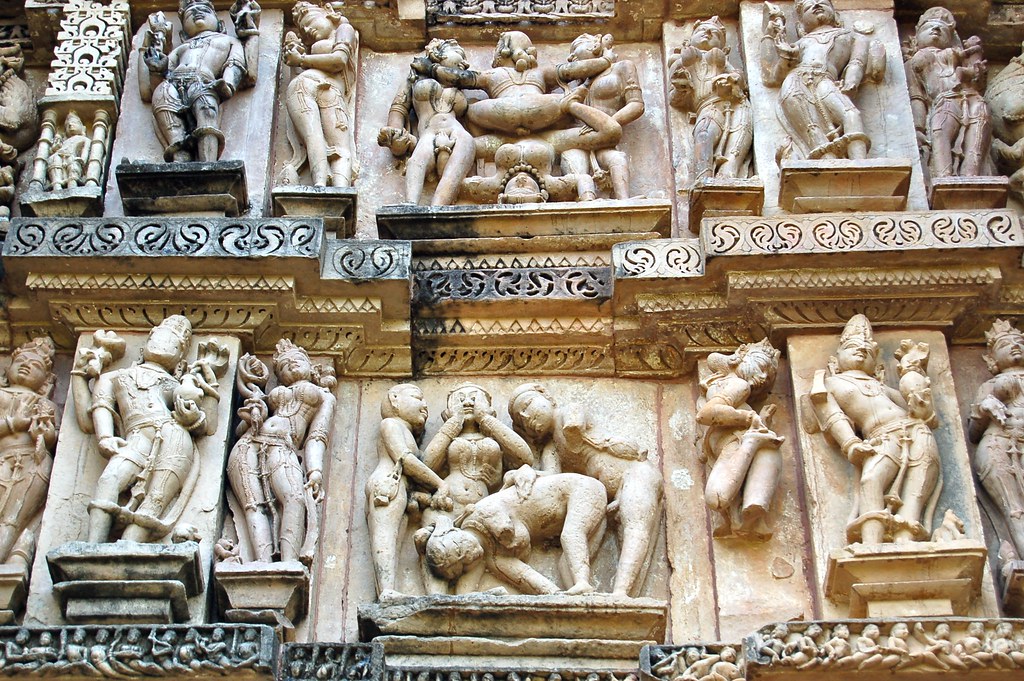
Erotic Sculpture and carving on Vishavanath Temple
Nandi shrine: The detached nandi pavilion forms an integral part of the architectural scheme of vishwanatha temple. The square pavilion rests on twelve pillars, enshrines a massive image of nandi. The bull vehicle of shiva which faces the main deity of vishwanath temple.
Nandi shrine: The detached nandi pavilion forms an integral part of the architectural scheme of vishwanatha temple. The square pavilion rests on twelve pillars, enshrines a massive image of nandi. The bull vehicle of shiva which faces the main deity of vishwanath temple.
Jain Temple(Eastern Group)
Parsvanatha temple:
Another feature of particular interest
is the shrine attached to the back of sanctum in other aspects the
temple shares the characteristics of the evolved khajuraho style including the exquisite finish and grace of the sculptures. This temple was built during the middle of 10th century A.D.
This largest and best preserved amongst the old jaina temples of khajuraho has
individual features of plan and design. The temple, even though of
sandhara architecture is not having the complimentary balconied windows,
which albeit is partially made up by the latticed windows.
 Parashavanath Temple
Parashavanath Temple
Another feature of particular interest
is the shrine attached to the back of sanctum in other aspects the
temple shares the characteristics of the evolved khajuraho style including the exquisite finish and grace of the sculptures. This temple was built during the middle of 10th century A.D.
Adinath temple:
Eastern Group and other Temples
This
jaina temple known after the enshrined image of adinatha. Originally
encompassed all the basic members of a nirandhara temple including
mandapa and the ardhamandapa which has since been completely lost. The
temple with its extant intact portion of garbhagriha and antarala and
the modern time plastered masonry of arched doorways and domical
ceilings is incongruous with the original structure. Conceived as a
saptratha temple both in plan and elevation, it bears closest kinship
with the vamana temple. However this temple is more evolved as observed
from the elegance of the sikhara and decoration in jangha compared to
those of vamana.this temple on stylistic considerations is understood to
have been built in the later part of 11th century A.D.
Lord Shantinath Statue
Shantinath Temple is another holy shrine in same premises along with a photo exhibition of Jain art and architecture.
Shantinath Temple is another holy shrine in same premises along with a photo exhibition of Jain art and architecture.
Eastern Group and other Temples
Duladeo temple: Dedicated to siva, temple faces east
and consists of a sanctum without ambulatory, vestibule, mahamandapa and
an entrance porch the sikhara is clustered round by three rows of minor
sikhara, its mahamandapa shows some peculiarities of design and
decoration, the mahamandapa is octagonal showing twenty apsaras bracket
which are elaborately crowned and heavily ornamented. The flying
vidyadharas, apsaras and other sculptures are generally stereo typed and
over burdened with ornamentation and in many cases lacks of relief some
or sculptures such as ashtavasu figures which are invariably depicted
with a crocodile mount in place of the bull, and the two dikpalas, yama
and nairiti wear their raisep curls in a stylized fan shade are
note-worthy. The original temple can be dated to the early half of the
12 th century A.D. and it has been extensively repaired and restored in a
later date.
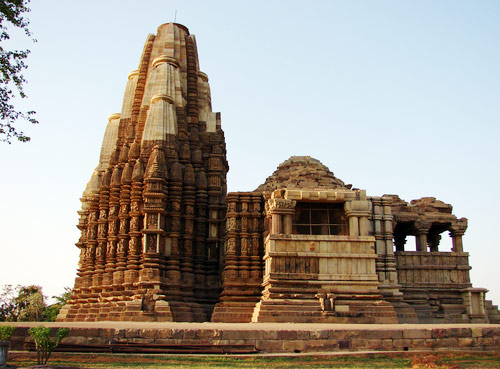
Duladeo temple

Duladeo temple
Ghantai Temple: The temple called because of the chain
and bell motifs prominently carved on the pillars. The extant portion
consists on an entrance porch and manamandapa each resting on four
pillars supporting a flat ceiling. The mahamandapa is entered through an
elaborate doorway and was originally enclosed be a solid wall of which
only a few supporting pilasters have survive the lintel on the door
contains an eight armed figure of yakshi, Chakreswari seatd on garuna.
The temple is dedicated to the digambara sect which is proved by the
sixteen-auspicious representation of the door lintel. The base of the
doorway shows ganga on the proper right and yamuna on the left flanked
by a female chauri bearer. The temple is datable to the end of 10th
Century A.D
Javari temple: This
temple built between circa 1075 and 1100 ad is well propotioned
architecture with sanctum, vestibule, mandapa and portico but without
pradakhinapatha.it has a remarkable makara- torana and beautiful
sikhara. It is decorated three bands of beautifully carved sculptures on
its outer walls.
The temple has a close resemblance with
the chaturbhuj temple at khajuraho besides there are certain other
features which resembles medieval temple architecture of central India.Javari temple
Vamana Temple: The Temple dedicated to the Vamana
incarnation Vishnu consists on plan of a Saptartha sanctum vestibule,
Mahamandapa with an entrance porch. The sanctum is niradhara and
enshrines an image of four armed vamana flanked by Chakkrapurusha on the
left and Sankhapurusha on the right. over the mahamandapa a peculiar
roof known as samwarana which is characteristic of the medieval temples
of western India is shown the doorway of the sanctum has seven hands
decorated with stenciled scrolls, dancing gangas, mithuna and lotus
petals, scrolls terminating in a figure of Naga Ganga and yamuna
standing in tri bhanga, flanked by female attendant on one side carrying
full base or garland and the other is flanked by a door keepers, the
lintel contain a four armed standing Vishnu and the niche sculptures
include Brahma and Siva.

Vamana Temple
The outer walls of the temples has two bands of sculptures which include graceful figures of sura sundaris, the sculptures of varaha, Narasimha and Vamana adorn the niches of the sanctum.On the basis of sculptural and architectural style, the temple is assigned to 1050-1075 A.D
Chaturbhuja temple: temple consists of a sanctum
without ambulatory, vestibule mandapa and an entrance porch. The temple
stands on a modest as this is the only temple at khajuraho which lacks
erotic sculptures. There are three bands of sculptures around the walls
and all the sculptures except the vidyadhars at the top row are stereo
type and without much life or expression, therefore there was a decline
in the sculptural art. The wall portion includes the images of dikpals
in the first row and of the ashtavasi in the middle one and the
remaining projections are carved with nymphs and the recesses with
mythical lions. The lower part of the doorway, the sanctum shows ganga
on the right and yamuna on the left standing in tri bhanga under a
canopy of leaves flanked by door's keepers. The image of pakshinamurti
which is housed in the sanctum is remarkable for its expression of
transcendental bliss.The temple is datable of 1100 A.D
